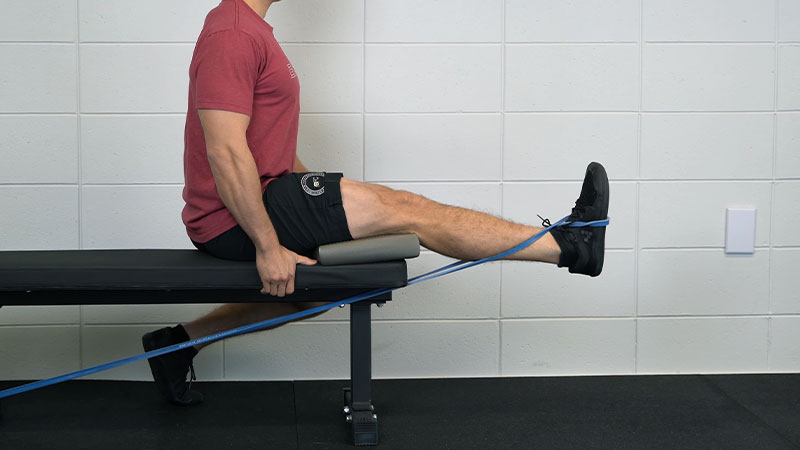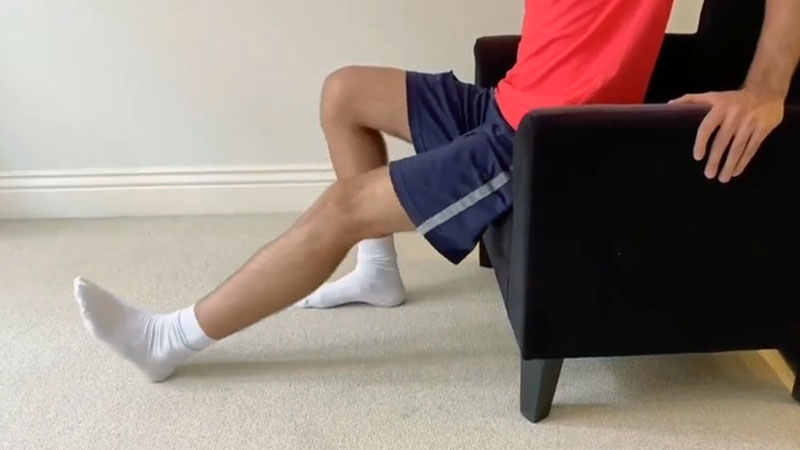As we age, maintaining healthy knees becomes increasingly important for maintaining mobility and independence. For seniors, incorporating chair knee exercises into their daily routine can be a game-changer.
These exercises are specifically designed to strengthen the muscles around the knee joint, improve flexibility, and alleviate discomfort associated with conditions like arthritis.
In this blog post, we’ll explore the best chair knee exercises tailored for seniors, each offering a range of benefits including enhanced joint health, increased stability and balance, and improved functional mobility.
Whether you’re looking to prevent injuries, manage pain, or simply stay active and independent, these exercises provide a safe and effective way to support your knee health and overall well-being.
8 Best Chair Knee Exercises For Seniors
Let’s not talk anymore and learn about the essential chair knee exercises designed specifically for seniors. Strengthen muscles, improve flexibility, and maintain knee health with targeted routines.
Whether you’re managing arthritis or aiming to enhance mobility, these exercises offer a safe and effective way to stay active and independent. Let’s check out the best chair knee exercises for seniors:
1. Seated Leg Extensions

Seated leg extensions are excellent for strengthening the quadriceps muscles in the front of your thighs, which are crucial for maintaining mobility and stability in your knees.
- Sit upright in a chair with your back straight and feet flat on the floor.
- Slowly extend one leg out in front of you, keeping it straight but not locked.
- Hold the extended position for a moment, feeling the contraction in your quadriceps.
- Slowly lower your leg back down to the starting position.
- Repeat the movement with the other leg.
Seated leg extensions help improve knee strength and stability, making activities like walking and climbing stairs easier and safer. Remember to keep the movement controlled and smooth, avoiding any jerky motions.
Aim for 10-15 repetitions on each leg, gradually increasing the number as you get stronger.
2. Chair Squats

Chair squats are effective for strengthening the muscles around your knees, including the quadriceps, hamstrings, and glutes. They also improve overall lower body strength and functional mobility.
- Start by sitting on the edge of a sturdy chair with your feet shoulder-width apart and flat on the floor.
- Keep your back straight and chest lifted as you stand up from the chair, using your leg muscles.
- Once standing, pause for a moment before slowly lowering yourself back down to the seated position.
- Control the movement throughout, focusing on engaging your leg muscles.
- Repeat the exercise for 10-15 repetitions.
Chair squats mimic the motion of sitting and standing, which are essential activities for daily living. By strengthening these movements, you can maintain independence and reduce the risk of falls.
Start with a comfortable number of repetitions and gradually increase as you build strength.
3. Seated Knee Lifts

Seated knee lifts target the muscles in the front of your thighs, helping to improve knee mobility and stability. They also engage your core muscles for added support and balance.
- Sit upright in a chair with your feet flat on the floor and your back straight.
- Lift one knee towards your chest as high as comfortable, engaging your thigh muscles.
- Hold the lifted position for a moment, feeling the contraction in your thigh.
- Slowly lower your leg back down to the starting position.
- Repeat the movement with the other leg.
Seated knee lifts are a low-impact exercise that can be tailored to your individual strength and flexibility.
They help improve range of motion in the knees and strengthen the muscles that support them. Aim for 10-15 repetitions on each leg, gradually increasing as you feel more comfortable.
4. Seated Leg Raises

Seated leg raises target the muscles in your thighs and hips, including the quadriceps, hamstrings, and hip flexors. They help improve lower body strength and stability, which is essential for maintaining balance and preventing falls.
- Sit on the edge of a chair with your feet flat on the floor and your back straight.
- Lift one leg straight out in front of you, keeping it parallel to the floor.
- Hold the raised position for a moment, focusing on engaging your thigh muscles.
- Slowly lower your leg back down to the starting position.
- Repeat the movement with the other leg.
Seated leg raises can be modified to suit your fitness level by adjusting the height of your leg lift. Start with a comfortable range of motion and gradually increase as you build strength and flexibility. Aim for 10-15 repetitions on each leg.
5. Seated Inner Thigh Squeeze

Seated inner thigh squeezes target the muscles on the inside of your thighs, helping to improve adductor strength and stability. They also engage your core muscles for added support and balance.
- Sit upright in a chair with your feet flat on the floor and a small ball or pillow between your knees.
- Squeeze your knees together, engaging your inner thigh muscles.
- Hold the squeeze for a few seconds, then release.
- Repeat the movement for 10-15 repetitions.
Seated inner thigh squeezes are a gentle yet effective exercise for strengthening the muscles that support your knees. They can help improve stability and reduce the risk of injury during daily activities.
Start with a light resistance and gradually increase as you get stronger.
6. Seated Knee Extensions with Resistance

Seated knee extensions with resistance target the muscles in your thighs and hips, including the quadriceps, hamstrings, and hip abductors.
They help improve lower body strength and stability, which is essential for maintaining balance and preventing falls.
- Sit upright in a chair with your feet flat on the floor and a resistance band around your ankles.
- Slowly extend one leg out to the side against the resistance of the band, keeping your knee straight.
- Hold the extended position for a moment, then return to the starting position.
- Repeat the movement for 10-15 repetitions on each leg.
Seated knee extensions with resistance provide an added challenge to traditional leg exercises, helping to strengthen muscles throughout your lower body. Start with a light resistance band and gradually increase as you build strength and stability.
7. Seated Heel Slides

Seated heel slides target the muscles in your thighs and hips, including the quadriceps, hamstrings, and hip flexors. They help improve lower body strength and flexibility, which is essential for maintaining mobility and preventing injury.
- Sit on the edge of a chair with your feet flat on the floor and your back straight.
- Slide one foot back as far as comfortable, bending the knee and keeping your heel on the floor.
- Hold the stretched position for a few seconds, then return to the starting position.
- Repeat the movement for 10-15 repetitions on each leg.
Seated heel slides are a gentle yet effective exercise for improving hip and knee mobility. They can help reduce stiffness and discomfort while improving overall lower body function.
Start with a comfortable range of motion and gradually increase as you get stronger and more flexible.
8. Chair Leg Circles

Chair leg circles target the muscles in your thighs and hips, including the quadriceps, hamstrings, and hip abductors. They help improve lower body strength and flexibility, which is essential for maintaining mobility and preventing injury.
- Sit upright in a chair with your feet flat on the floor.
- Extend one leg out in front of you, then make small circles with your foot, moving clockwise for several repetitions.
- Reverse the direction and make circles counterclockwise for several repetitions.
- Repeat the movement with the other leg.
Chair leg circles are a simple yet effective exercise for improving hip and knee mobility.
They can help reduce stiffness and discomfort while improving overall lower body function. Start with a small range of motion and gradually increase as you get stronger and more flexible.
Benefits of Chair Knee Exercises For Seniors
Chair knee exercises offer a plethora of benefits for seniors, contributing to their overall well-being and quality of life. Here are some of the key benefits:
Improved Joint Health
Engaging in chair knee exercises helps maintain the health of the knee joints by promoting flexibility and reducing stiffness.
These exercises increase blood flow to the joint, delivering essential nutrients and oxygen that support joint function and reduce the risk of degenerative conditions such as arthritis.
Enhanced Strength and Stability
Chair knee exercises target the muscles surrounding the knee joint, including the quadriceps, hamstrings, and calves. Strengthening these muscles improves stability and balance, reducing the risk of falls and injuries.
Enhanced lower body strength also makes daily activities such as walking, climbing stairs, and getting up from a seated position easier and safer.
Increased Range of Motion
Regularly performing chair knee exercises helps seniors maintain or improve their range of motion in the knees.
This flexibility is essential for maintaining mobility and independence in activities of daily living, such as bending down to pick up objects or getting in and out of a car.
Pain Management
For seniors experiencing knee pain or discomfort, targeted chair knee exercises can help alleviate symptoms by strengthening the muscles that support the knees.
Stronger muscles provide better stability to the joint, reducing stress on the surrounding tissues and easing pain associated with conditions like osteoarthritis or tendonitis.
Enhanced Functional Mobility
Chair knee exercises focus on movements that mimic everyday activities, making them highly functional for seniors.
By improving strength, flexibility, and coordination in the lower body, these exercises translate directly to improved mobility and independence in performing tasks essential for daily living.
Maintained Independence
As seniors age, maintaining independence becomes increasingly important for their overall well-being.
Chair knee exercises help preserve mobility and functional abilities, enabling seniors to continue living independently and participating in activities they enjoy without reliance on others for assistance.
Mental Health Benefits
Engaging in regular exercise, including chair knee exercises, has been linked to improved mental health outcomes for seniors. Exercise releases endorphins, which are neurotransmitters that promote feelings of happiness and well-being.
Additionally, staying physically active can reduce feelings of depression and anxiety commonly experienced in older adults.
Prevention of Falls and Injuries
Weakness and instability in the lower body are significant risk factors for falls among seniors.
By strengthening the muscles around the knees and improving balance and coordination, chair knee exercises help reduce the risk of falls and associated injuries, such as fractures or head trauma.
Incorporating chair knee exercises into a senior’s daily routine offers numerous physical and mental health benefits, promoting overall well-being and longevity.
Regular participation in these exercises can contribute to maintaining independence, reducing pain and stiffness, and improving overall quality of life for older adults.
Wrapping Up
As you know, the benefits of chair knee exercises for seniors cannot be overstated. These exercises offer a targeted approach to improving strength, flexibility, and mobility in the lower body, specifically focusing on the muscles surrounding the knee joint.
For sure, chair knee exercises contribute to maintaining independence, reducing the risk of falls and injuries, and promoting overall well-being. Well, it’s crucial for seniors to practise these exercises with caution and adhere to safety guidelines.
It’s advisable to start slowly and gradually increase intensity and repetitions as strength improves. Seniors should listen to their bodies, avoiding any exercises that cause pain or discomfort.
Additionally, consulting with a healthcare professional before beginning any new exercise regimen is recommended, especially for individuals with existing medical conditions or mobility limitations.
With proper guidance and diligence, chair knee exercises can be a valuable component of a senior’s wellness routine, supporting their health and vitality for years to come.
I am a fitness instructor and I have been in the industry for 9 years. I have a passion for health and fitness.
I am a fitness instructor with over 9 years of experience in the industry. My passion is health and fitness and I would love to share my knowledge with you!